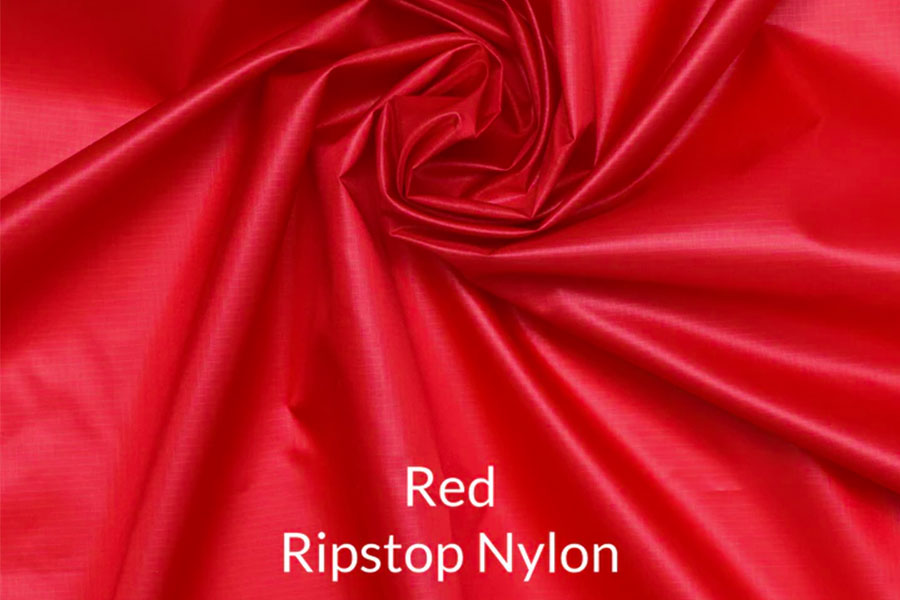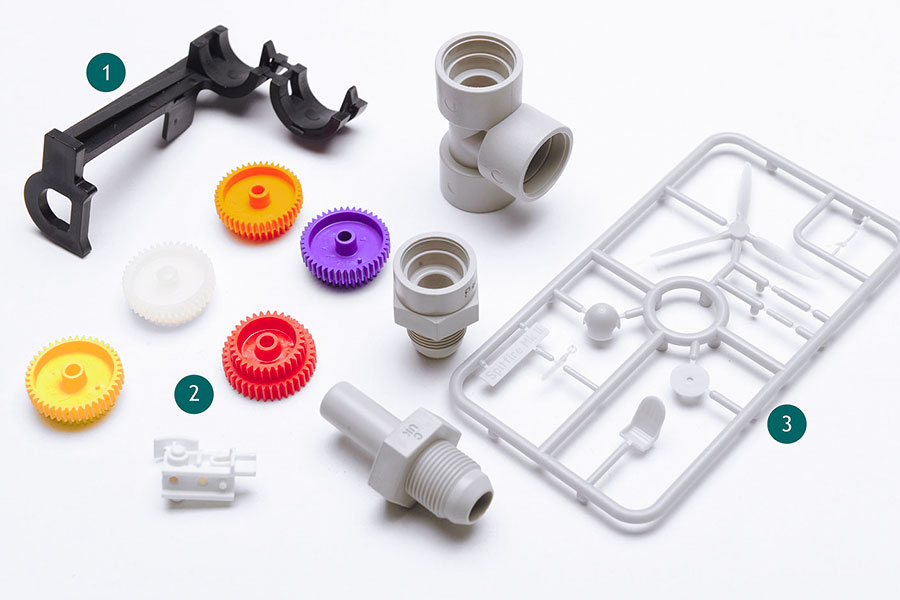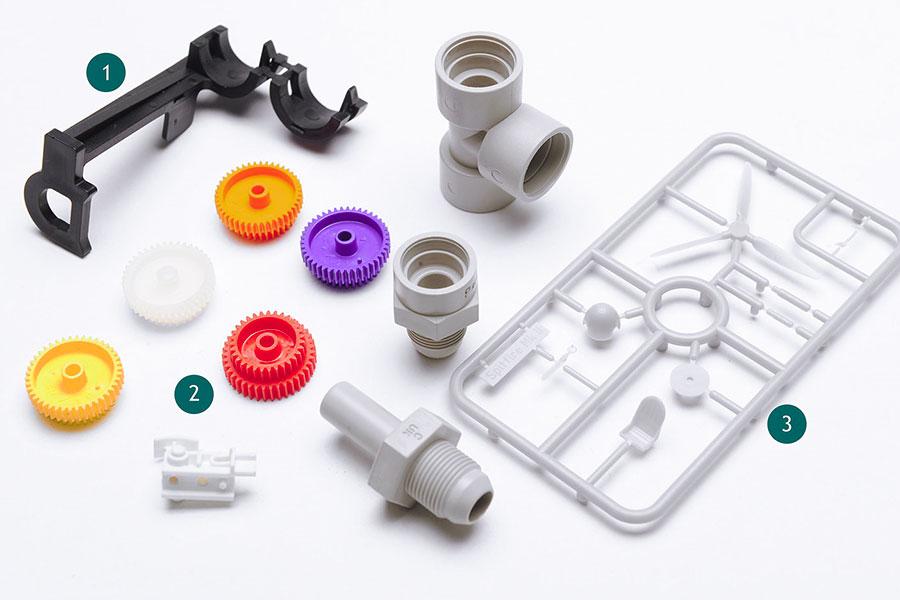More than a fiber, it's the “workhorse” of engineering plastics.
Are you looking for a material that is stronger than regular plastic and lighter than metal? The answer is often nylon.
Nylon is used in a variety of applications, from toothbrushes to aerospace components. Most people first encounter nylon through clothing or rope, thinking it's just a tough fiber. However, in the engineering field,nylon has become a “mainstay” of high-performance engineering plasticsdue to itsexcellent mechanical properties, abrasion resistance and lightweight characteristics.
Nylon stands out because of its unique molecular structureand customizability. By adapting formulations and processes, it can exhibitvarying strengths, heat resistance and chemical stabilityto meet the needs of applications ranging from everyday items to extreme environments, pushing the boundaries of product design.
To save you valuable time, here is a quick summary of the core conclusions:
| Core Features | What it means to your product | Common application examples |
|---|---|---|
| High strength and toughness | Bear high loads, impact resistance, can replace metal parts, reduce weight | Gears, bearings, structural parts (housing, brackets) |
| Excellent wear resistance and self-lubrication | Significantly extend the life of moving parts, reduce friction loss, and reduce noise | Guide rails, bushings, wear-resistant gaskets, industrial nylon mesh |
| Good high temperature resistance | Can maintain stable performance in high temperature environments and adapt to harsh conditions | Automotive engine compartment components, electronic connectors, fan impellers |
| Excellent chemical resistance | Resist oil, grease, alkali and various solvents to improve durability | Automotive fuel lines, industrial storage tanks/containers, hydraulic components |
| Lightweight | Significantly reduce component weight, improve energy efficiency and portability | Automotive parts, sports equipment, portable device housings |
| Good electrical insulation | Provide reliable electrical protection in dry or low humidity environments | Electrical connectors, circuit breaker components, coil skeletons |
| Easy to process and design freedom | Easy to injection mold complex shapes, achieve design flexibility, and reduce costs | Various customized structural parts, housings, fasteners |
This guide will provide an in-depth look at the key properties of nylon as an engineering plastic, typical application scenarios and how to choose the most appropriate type of nylon for your project needs and explain how they can have a direct impact on the performance of yourinjection molded partsand the finalinjection molding price. After reading this blog, you will realize that this seemingly ordinary material may be the key to your next innovative project.

Here’s What You’ll Learn
- A quick material selection guide:Help you determine whether nylon is suitable for your project needs within 30 seconds
- In-depth analysis of 7 core characteristics:From molecular structure to actual performance, reveal the scientific principles behind each characteristic
- Industry application decryption:Innovative uses of nylon that experts in the automotive/electronics field are reluctant to disclose
- Pitfall avoidance guide:5 most common material selection errors and how to avoid them
- Future trends:How the latest breakthroughs in modified nylon technology will change the manufacturing landscape
Now, let's start exploring the infinite possibilities of nylon materials!
Why trust this guide? Practical experience from LS injection molding experts
On the Internet, you can find countless articles about nylon materials. So why is this one worth your time to read?
Because we're not theorists, we're practitioners.
My name is Gloria and I have been working atLS Injection Moldingfor over15 years. Our shop isn't a lab where we do experiments, it's a real-world battlefield where we're competing every day withhigh-strength engineering plastics, precision injection molding and demanding industrial needs.
Here, we don't just “know” the difference between nylon 6 and nylon 66-we rely on that knowledge to ensure the success of our products.
- The wear resistance of the nylon gears and bearings we manufacture for theautomotive industry directly affects the life of the gearbox.
- The biocompatibility and chemical resistance of the nylon components we develop for medical devices are related to patient safety.
- The strength and dimensional stability of the lightweight nylon housings we produce forconsumer electronicsdetermine product reliability.
Over the past decade,our team has successfully injection molded more than[100,000+] nylon parts, ranging fromminiature precision gears to large industrial structures. Each project has taught us some key lessons:
- Which nylon modifications are best suited for high-load applications?
- How can injection molding parameters be optimized to reduce warpage and shrinkage?
- What additives enhance nylon performance in high-temperature or chemical environments?
Every recommendation, every data point in this guide comes from our real-life successes (and some costly lessons learned early on). We've stepped in potholes so you don't have to. We're not sharing textbook generalities - we're sharing real-world experience that's been validated throughinjection molding machinecommissioning, mold optimization, and rigorous testing.
So be confident that what you're reading here is exactly the kind of knowledge we apply every day in our production. Together, let's choose the right nylon and make better products.
How to Choose the Right Nylon for Your Project: A Simple Decision-Making Framework
Before we delve into the complex characteristics of eachnylon material, let's get straight to the point. In product development, time is competitive, and a clear material selection process is essential. Please answer the following two questions in sequence. This method will help you quickly lock in themost suitable nylon typein 90% of cases.
Step One: At what “temperature” does your product operate?
This is the most important question you must answer first:
Question:Does the part need to maintain stable performance in an environment exceeding 100°C for a long period of time?
Decision path:
- No (normal temperature or short-term high temperature)→Choose PA6 (Nylon 6)
Economical and affordable basic choice
Typical applications: daily consumer goods, general mechanical parts
Advantage: cost is 15-20% lower than PA66, meeting most conventional needs
- Yes (continuous high temperature environment)→ Choose PA66 (Nylon 66)
Better heat resistance
Typical applications:automotive engine compartment components, high-temperature electronic components
Advantage: heat deformation temperature is about 30-40°C higher than PA6
- Extreme high temperature (>150°C) → Consider reinforced nylon or special nylon
Professional choice: glass fiber reinforced PA66 (PA66-GF30)
Advantage: heat deformation temperature can be increased to more than 200°C
Step 2: How sensitive is your product to "dimensional stability"?
Now, for the type of base material you have chosen, consider:
Question: Does a part have very tight dimensional tolerances that need to remain accurate even in a wet environment?
Decision path:
ForPA6/PA66 base materials:
- General requirements → Standard materials + humidity treatment
Treatment method: Boiling treatment (2-4 hours)
Effect: Can reduce the later dimensional changes by more than 50%
- High precision requirements → Must choose reinforcement materials
Recommended solution: 30% glass fiber reinforcement (PA6-GF30/PA66-GF30)
Advantages: Water absorption is reduced by 40-50%, and dimensional stability is increased by 3-5 times
Professional advice:
"For applications that require metal-level precision, we recommend:
PA66+50% glass fiber (shrinkage is only 0.2%)
Mineral-filled nylon (best dimensional stability)"
Pro-Tip
"When you contact us for injection molding services, please be sure to provide the following information:
- Operating temperature range (Is it high temperature for a long time? Peak temperature?)
- Humidity environment (Is it high humidity or does it need to be waterproof?)
- Critical dimensional tolerances (Does it require extremely high precision?)
These data are the key basis for us to recommend the best material for you, optimize theinjection molding process, andaccurately calculate the injection molding price."
Your quick guide to nylon selection
| Requirement scenario | Recommended material | Reason |
|---|---|---|
| Low cost + room temperature application | PA6 (nylon 6) | High cost performance, meets most needs |
| High temperature environment (>100°C) | PA66 (nylon 66) | Higher heat resistance, better long-term stability |
| High precision + low water absorption | PA66 or glass fiber reinforced nylon | More stable dimensions, suitable for precision parts |
| Extreme environment (high temperature + high load) | Glass fiber/mineral filled nylon | Best comprehensive performance, but higher cost |
Next step:
"If you are still not sure which nylon is best for your project, consult our material engineers now. We will provide customized solutions based on your specific needs andestimate the injection molding costfor you."
"As an old engineer who has worked in theLS injection molding teamfor 15 years, I have summarized a simple and rough formula for material selection: first look at the temperature - if it exceeds 100℃, choose PA66 without hesitation, and use PA6 at room temperature to save costs; then look at the precision - ordinary parts can be used by adjusting the humidity, and precision parts must be reinforced with glass fiber; finally, think about special needs - if it needs to be wear-resistant, add molybdenum disulfide, if it needs to be conductive, add carbon fiber, and if it needs to be FDA-grade for food and medical use. Remember these three steps, andnext time you come to our workshop for consultation, you will be guaranteed to be able to exchange secret codes with our material experts!"

In-depth analysis: 7 key properties of nylon
Nylon performance quick reference table
| Performance | Advantages | Typical applications |
|---|---|---|
| High strength and durability | High tensile and impact resistance, stronger after glass fiber reinforcement | Gears, structural parts, tool handles |
| Wear resistance and self-lubrication | Low friction, maintenance-free, long life | Bearings, guide rails, nylon mesh (nylon mesh) |
| High temperature resistance | PA66 is better than PA6 in high temperature resistance, and glass fiber reinforcement is better | Automotive engine parts, electronic heat sinks |
| Chemical resistance | Oil and alkali resistance, but not strong acid resistance | Fuel pipes, chemical containers |
| Electrical insulation | High resistivity, suitable for electronic components | Connectors, switch housings |
| Lightweight | Low density, replace metal to reduce weight | Drone frames, sports equipment |
| Hygroscopicity management | Pre-drying & humidity adjustment is required, which affects dimensional stability | Precision parts require special treatment |
In the field of engineering plastics,nylon (polyamide) has been the preferred polymer for most usesdue to its outstanding general properties. In the following, each of the seven basic properties of nylon will be explained in detail to help you better understand how they affect your product design, manufacturing, and final performance.
1. High Strength and Durability (Toughness)
Basic Benefits:
Nylon has excellent tensile strength(PA66 can be up to 80-90 MPa, PA6 up to 70-80 MPa), making it capable of withstanding high loads.
Excellent impact resistance, even at low temperatures is tough, suitable for components subject to impact (e.g., gears, housings).
On glass fiber reinforcement (e.g., PA6-GF30), strength is raised up to 2-3 times and stiffness is greatly increased, comparing to some metals.
Why is it important?
In applications such as structural parts, moving parts, tools, etc., the toughness ofnylon can replace metal to offer lightness and cost savings.
Glass fiber reinforced nylon is particularly suited to high load and high fatigue life requirement components (e.g., automotive engine brackets, industrial robot arms).
2. Exceptional Wear Resistance and Self-lubrication
Core Benefits:
Nylon has an extremely low coefficient of friction(0.1-0.3, nearing PTFE levels), and is thereby particularly suited as a self-lubricating material.
Exceptional wear resistance, ideally suited to long-life sliding or rotating parts such as bearings, guides, bushings, etc.
Special modifications (e.g., the addition of MoS₂ or silicone oil) can further boost wear resistance and part life.
Why is it important?
Reduce lubrication requirements and conserve maintenance costs (e.g., oil-free lubricating conditions such as food equipment and medical devices).
E.g., for applications where long-term wear resistance is required, e.g., high-durability nylon mesh, conveyor belts, gears, etc.
3. Superior thermal stability
Basis of benefits:
PA6 has a melt point around 220°C and a heat deformation temperature (HDT) of around 65°C (unreinforced), suitable for ambient temperature conditions.
PA66 has a greater melt point (~260°C) and a HDT of up to 90°C (unreinforced), suitable for repeated high-temperature application (e.g., an automobile engine bay).
After glass fiber reinforcement (PA66-GF30), HDT can be raised to 250°C+, which is suitable for severe high-temperature uses.
Why is it important?
In applications at high temperature such as automobile, electronics, and industrial machinery, nylon can maintain mechanical properties and avoid deformation or failure.
Accurate selection ofPA6 or PA66 can achieve maximum cost-performance ratioand avoid over-design.
4. Good chemical resistance (Chemical Properties of Nylon)
Core advantages:
Oil-proof, grease-proof, and weak alkali-proof, suitable for fuel system and lubricating oil conditions (e.g., oil pump parts and fuel tank).
High resistance to alcohols, ketones, and hydrocarbon solvents.
Not resistant to strong acids (e.g., concentrated sulfuric acid and hydrochloric acid) and oxidants, so use with care in choice of application conditions.
Why is it important?
Chemical resistance in automobile, chemical, and food industries ensures long-term and stable operation of component.
The right grade shall be selected according to the actual contacting with the chemical (for instance,PA12 is stronger regarding acidsand alkali but more expensive).
5. Excellent Electrical Insulation
Major advantages:
Nylon has high volume resistance around 10¹⁴-10¹⁶ Ω·cm, thus it is a very good insulating material.
It possesses excellent resistance to arc and suggested for electrical products like electrical connectors, switches, and relay housings.
Why is it important?
In electrical appliances and alternative energy (for example, battery brackets), nylon can replace traditional insulating materials with mechanical properties.
The glass fiber reinforced nylon is available to be utilized for components of high-voltage insulation, but one should take into consideration the effect of hygroscopicity on the performance of the insulation.
6. Lightweight Nature
Core Advantages:
Nylon has a density of about 1.13-1.15 g/cm³, which is much lower than aluminum (2.7 g/cm³) and steel (7.8 g/cm³).
In the fields of automobiles, aerospace, consumer electronics, etc., it can significantly reduce weight and energy consumption.
Why is it important?
Lightweight design can improve product portability and energy efficiency (such as drone structural parts and sports equipment).
Combined with high strength, nylon has become one of the first choices for metal replacement.
7. Hygroscopicity - A double-edged sword for experts
Core features:
Nylon absorbs moisture from the air (balanced moisture absorption rate PA6 ~3%, PA66 ~2.5%), affecting performance:
Advantages: Improved toughness and impact resistance after water absorption.
Disadvantages: May cause dimensional expansion (0.5%-3%), affecting the tolerance of precision parts.
Why is it important?
Professional injection molding servicesmust include:
Material pre-drying (drying at 80-100°C for 4-6 hours to avoid injection bubbles).
Humidity conditioning (parts post-processing to stabilize size and performance).
For high-precision parts, low-hygroscopic nylon (such as PA46, PA12) or glass fiber reinforced models can be selected.
Next step: How to optimize your nylon parts?
"Understanding the performance of nylon is only the first step. Material selection, process optimization and cost control are equally critical. If you need professional advice, our injection molding services team can provide you with material selection, drying process guidance, and accurately calculate the injection molding price."
Consult now to get a customized solution!
Nylon has become a leader in engineering plasticsdue to its comprehensive properties such ashigh strength, wear resistance, self-lubrication, high temperature resistance, chemical corrosion resistance, electrical insulation, and lightweight, but its hygroscopicity needs to be controlled through professional drying and humidity control processes. Reasonable selection (such as PA6/PA66/glass fiber reinforcement) can balance performance and cost, making it a perfect substitute for metal or ordinary plastics in the fields of automobiles, electronics, machinery, etc., achieving a double breakthrough in lightweight and durability.

Practical case analysis: from customer needs to successful products
Theory must ultimately serve practice. The following are examples ofhow LS uses its deep understanding of nylon properties to solve practical problems for customers.
Case 1: Analysis of lightweight solutions for automobile engine intake manifold
Case 1: automobile engine intake manifold
Customer's core requirements:The customer found us at that time, the core is to do an engine intake manifold. This part has several hard requirements: first, it must be light, can reduce the weight of the best; second, to be able to withstand the high temperature of the engine compartment, about 150 degrees is the norm; third, not afraid of oil, oil and gas these things for a long time immersion; fourth, the part itself, the structure of the bends and twists, quite complex, not good to do.
Our plan and action:After analyzing these requirements, I suggested that the team chooseglass fiber reinforced nylon 66(is often referred to as GF-PA66). Mainly for its two points: First, its own heat resistance is good enough, 150 degrees is no problem at all; Second, the addition of glass fiber strength, stiffness are up, strong enough. However, the structure of the part is really complex, we are worried that the plastic in the mold does not flow well, not filled or defective. Therefore, before we opened the mold, we specifically used software to do a detailed mold flow analysis, simulating how the plastic flows and cools in the mold. Based on the results of the analysis, we repeatedly adjusted the design of the mold, such as the position and size of the inlet, to ensure that the plastic could smoothly fill every corner of the mold even for such a complex shape.
Final Result:The solution came to fruition! We successfully replaced the customer's metal (aluminum) intake manifold with a GF-PA66 plastic intake manifold. The effect is very obvious: the weight has been reduced by more than 40%, which helps a lot to reduce the weight of the whole car. Moreover, not only the material itself may be cheaper, but more importantly, the plastic parts are easier to make complex shapes, and the production efficiency is also higher, the overall calculation, the customer's overall cost is reduced. The customer is very satisfied with the effect of weight reduction and cost reduction.
Case 2: Precision electronic connector
Customer's core requirements:
communication equipment customer approached ourLS teamto make a small electronic connector with three core requirements: extremely high electrical insulation (anti-leakage), ultra-high dimensional stability (small size, dense pins), and the need to pass a flame retardant rating test (e.g. UL94 V-0). With these requirements superimposed on a small size, the challenge is not small.
Our solution and actions:
After analyzing the requirements, we selected flame retardant modified nylon 6 (FR-PA6): it has excellent insulating properties on its own and meets the flame retardant requirements after modification. There are two key process controls:
1. Strict drying:For the moisture-absorbent characteristics of nylon, the raw material must be fully dried by 120℃ hot air for at least 4 hours to completely eliminate moisture and preventinjection moldingdefects and dimensional fluctuations.
2. Precision injection molding:for small sizes and tight tolerances (such as pin spacing ± 0.02mm), the use of ultra-high-precision molds, and injection temperature, pressure and other parameters are extremely strict control to ensure accurate filling and dimensional stability.
Final Result:
The result is remarkable! The product passed 100% of the high-voltage insulation tests, with high dimensional consistency and all key dimensions stabilized within tolerances. This made the product a perfect match for the customer's automated assembly line, allowing for a smooth and efficient installation. The customer was very satisfied with the reliability and assembly efficiency of the product, and theproject proved our LS team's core competence in high-precision electronic connector injection molding.
Through these two typical cases, we have proved thatprecise nylon materialselection (such as GF-PA66 for high temperature and FR-PA6 for precision parts) combined withprofessional injection molding technology(drying treatment/mold flow analysis) can not only meet the requirements of stringent working conditions (150°C temperature resistance/high voltage insulation), but also achieve commercial value such as 40% weight reduction and cost reduction, ultimately transforming customers' technical problems into market competitive advantages.
FAQ - Answers to all your questions about nylon
1. What are the most important properties of nylon?
In the opinion of our LS team, the most core and most valued properties of nylon are its excellent mechanical strength and toughness, excellent wear resistance, good chemical resistance (especially to oil and solvents) and self-lubrication. These properties enable nylon to work stably in harsh environments with high loads and high friction, becoming a lightweight solution to replace metals. Of course, its easy processing and relatively low cost are also the basis for its wide application.
2. What are the main uses of nylon?
Nylon has a wide range of uses, mainly divided into two areas: fibers and engineering plastics. As a fiber, it is widely used in clothing (such as sportswear, underwear, socks), carpets, ropes and seat belts. As an engineering plastic, it is one of the preferred materials for our team in automotive parts (such as radiator tanks, engine hoods, gears), electronic appliances (such as connectors, coil bobbins), industrial parts (such as gears, bearings, pulleys) and consumer products (such as power tool housings, zippers, sports equipment) due to its excellent strength, wear resistance and heat resistance.
3. What are the properties of nylon fibers?
The most outstanding properties of nylon fibers (such as nylon) are their very high strength, excellent elastic recovery (good wrinkle resistance), superior abrasion resistance, and relatively light weight. It also has good durability, quick drying properties, and resistance to mold and many chemicals. However, it is less hygroscopic than natural fibers (e.g., cotton), is prone to static electricity, and has slightly weaker light and heat resistance (under prolonged exposure) than some synthetic fibers (e.g., polyester).
4. What are the main differences in the performance of nylon 6 and nylon 66?
Nylon 6 and nylon 66 are the two most commonly used types, and the main differences are melting point, crystallinity and processability. Nylon 66 has a higher melting point (about 260°C vs. about 220°C for nylon 6) and a higher crystallinity, which gives it better rigidity and strength retention at high temperatures, and its dimensional stability is usually slightly better. Nylon 6 has a lower melting point, a wider processing window, better fluidity, easier molding, and usually better toughness (especially low-temperature impact toughness), and slightly higher water absorption. In terms of cost, nylon 6 is usually more advantageous.
5. What is nylon 7? How is it different from ordinary nylon (e.g. 6 or 66)?
Nylon 7 (commonly referred to as Nylon 7 or Nylon 77, synthesized from monomers derived from castor oil) is a long carbon chain nylon of bio-based origin. It is most different in that its monomers are derived from a renewable resource (castor oil), which has environmental attributes. Performance-wise, it inherits the excellent strength and abrasion resistance base of nylon, but is significantly less hygroscopic than nylon 6 or 66, meaning that its dimensional stability and electrical insulation properties are less affected by humidity. At the same time, it typically has better flexibility, chemical resistance (especially to hydrolysis) and lower density. Of course, its cost and commercialization are not currently comparable to that of nylon 6/66, and it is mainly used in special applications where there is a high demand for low moisture absorption, biobased content or specific chemical resistance.
Summary
In the view of the LS team,nylon (polyamide) has established its position as the king of irreplaceable key engineering plasticsand synthetic fibers from daily consumer goods to demanding industrial applications, with its seven core characteristics of excellent strength and toughness, top wear resistance and self-lubrication, good chemical resistance, excellent processability and cost-effectiveness, high elasticity and durability (fiber state), controllable hygroscopicity and diverse type selection. If you are looking for a professional injection molding service provider,LS's team of engineers is ready to provide you with full supportfrom material selection to custom injection molding manufacturing.Contact us nowfor free technical consultation and project quotation!
📞 Phone: +86 185 6675 9667
📧 Email: info@longshengmfg.com
🌐 Website:https://lsrpf.com/
Disclaimer
The content of this page is for informational purposes only.LS SeriesNo representations or warranties of any kind, express or implied, are made as to the accuracy,completeness or validity of the information. It should not be inferred that the performance parameters, geometric tolerances, specific design features, material quality and type or workmanship that the third-party supplier or manufacturer will provide through the LS network. This is the responsibility of the buyerAsk for a quote for partsto determine the specific requirements for these parts.please Contact us Learn more information.
LS Team
LS is an industry-leading companyFocus on custom manufacturing solutions. With over 20 years of experience serving more than 5,000 customers, we focus on high precisionCNC machining,Sheet metal fabrication,3D printing,Injection molding,metal stamping,and other one-stop manufacturing services.
Our factory is equipped with more than 100 state-of-the-art 5-axis machining centers and is ISO 9001:2015 certified. We provide fast,efficient and high-quality manufacturing solutions to customers in more than 150 countries around the world. Whether it's low-volume production or mass customization,we can meet your needs with the fastest delivery within 24 hours. chooseLS TechnologyIt means choosing efficiency, quality and professionalism.
To learn more, please visit our website:www.lsrpf.com







